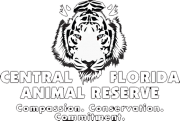View the article as published in The Orlando Sentinel
 Unabridged version: “A Walk on the Wild Side”
Unabridged version: “A Walk on the Wild Side”
by K. Simba Wiltz
Generally speaking, it is a bad idea to get into a staring contest with a tiger. That kind of body language rubs their stripes the wrong way and can lead to misunderstandings. I would prefer not to leave room for interpretation of my intent, especially when standing less than a yard from one such 500 lb. creature—with a freshly prepared tray of meat in my hands.
This kind of scenario might be a recipe for disaster save a few not-so-minor details. She’s safely inside her enclosure and I am standing on the outside. Her pale blue eyes glint playful defiance, not lethal intent. Attention is currency for her, and the joy of payment has not lessened after 10 years together.
The standoff ends when I concede.
“It’s your idea, Winagi” I say.
With a cheery “chuff”—a tiger greeting—she ambles into the shift enclosure. I secure the gate lock behind the last stripe and begin the entry procedure to start work.
This is a brief glimpse into the unique world of over 40 lions, tigers, leopards, and cougars currently residing at the Central Florida Animal Reserve in Brevard County. With the area around the Reserve changing, the County gave us until early 2015 to move. Fortunately, Osceola County is welcoming the Reserve and a new facility is currently in construction. To date, we have raised a little over half of the $1 million it takes to build the Reserve and move the exotic cats to their new home.
I place the tray of food in Winagi’s feed spot as volunteers have many times before. The organization is comprised entirely of volunteers who feed and care for all the magnificent residents. We rely on community support to care for the animal residents who eat 7 to 10 pounds of meat each day.
America used to have more captive tigers than wild tigers, most in private hands. Changing times have left fewer places for these big cats can go. Big cats have no social safety net, and if they end up in trouble, the lucky ones land in dedicated sanctuaries like the one being built in Central Florida.
The new reserve in Osceola County will feature larger enclosures for the animal residents who will call this their home. The program provides lifelong care and a non-breeding approach focused on doing what’s right for the animals. That includes never euthanizing healthy animals.
Many in the community are already supporting the move to Forever Florida. I invite everyone in the community to visit The Move Campaign to learn about the amazing big cats moving to Osceola County, and how you can get involved in the move.
With maintenance tasks complete and food placed, I turn back to the patient white tiger. Her black and white coat ripples of muscle as she re-enters. She affectionately rubs her head against the enclosure before me and continues to her meal. I smile. The joy of assisting these amazing creatures is worthy of our support.
K. Simba Wiltz
Sr. Vice President, CEO
Central Florida Animal Reserve
December 29, 2014
Contact Dr. Wiltz here

